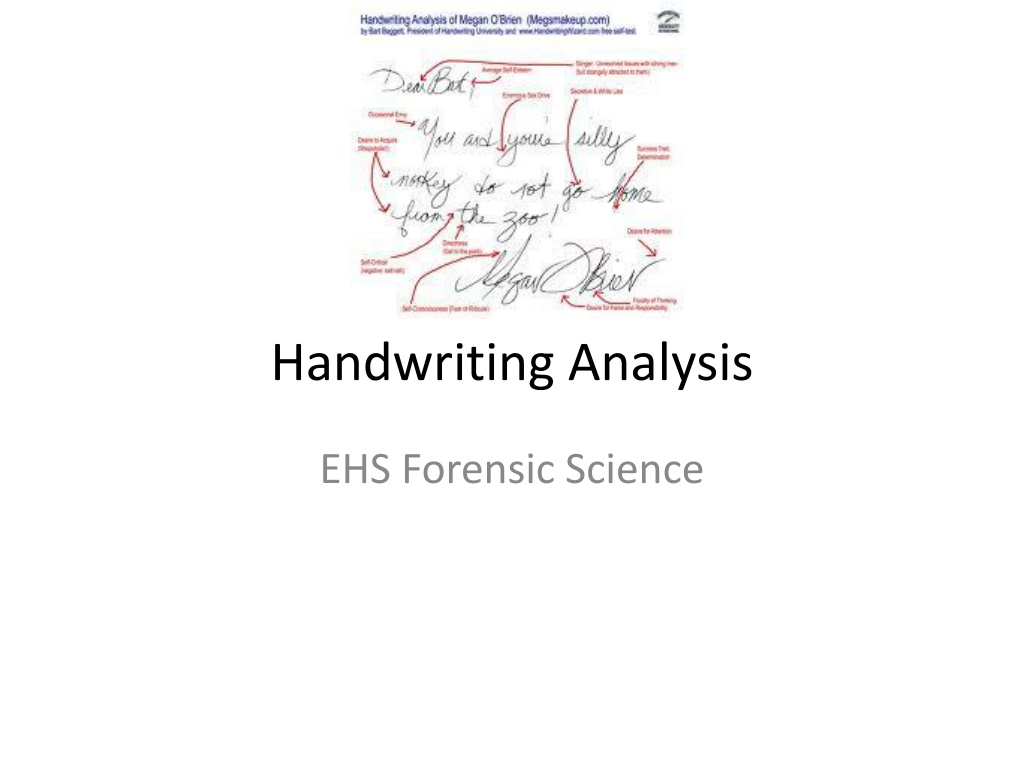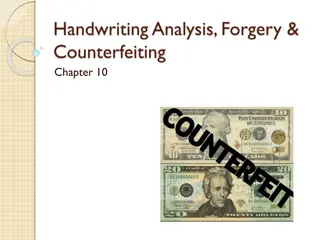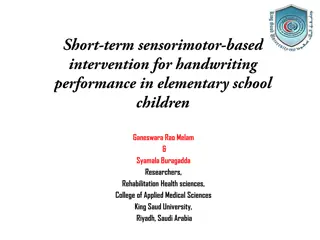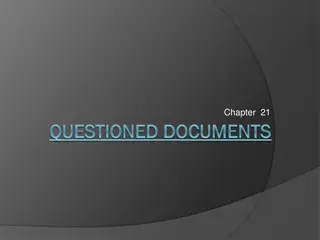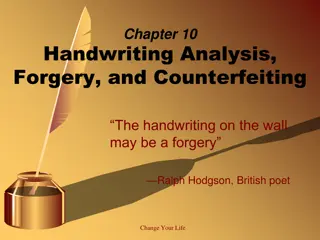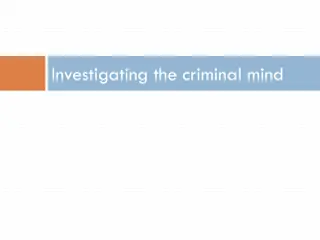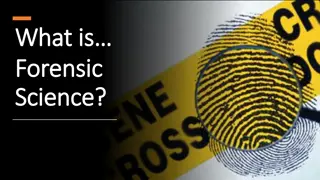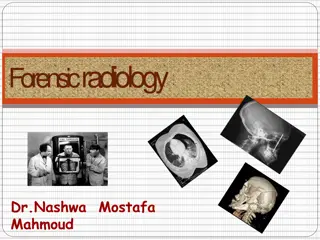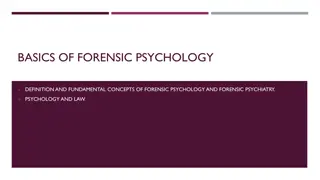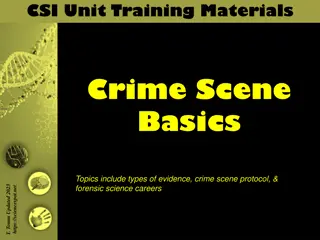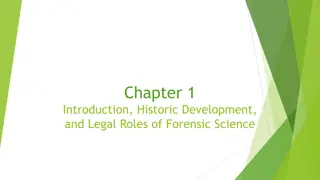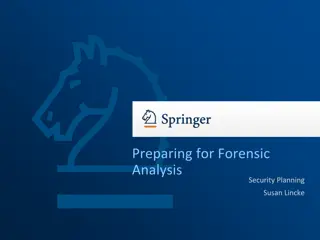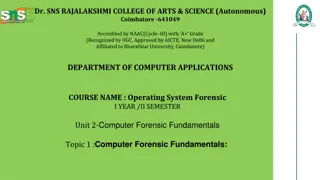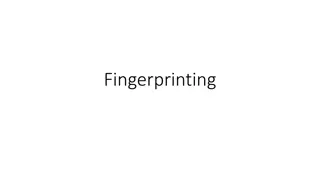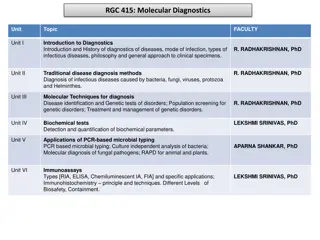Understanding Handwriting Analysis in Forensic Science
Handwriting analysis, a crucial aspect of forensic science, involves examining and comparing questioned documents with known material to determine authenticity. Examples of questioned documents include signatures, handwriting, typewriting, and more. Experts investigate various factors like letter size, spacing, slant, and style to identify document authors accurately. Graphologists, though not part of forensic science, can offer insights into personality traits through handwriting analysis, aiding investigations.
Download Presentation

Please find below an Image/Link to download the presentation.
The content on the website is provided AS IS for your information and personal use only. It may not be sold, licensed, or shared on other websites without obtaining consent from the author. Download presentation by click this link. If you encounter any issues during the download, it is possible that the publisher has removed the file from their server.
E N D
Presentation Transcript
Handwriting Analysis EHS Forensic Science
Video links http://www.pbs.org/opb/historydetectives/te chnique/document-examination/ document historical http://www.youtube.com/watch?v=qGknAMy xRPE FBI
Handwriting Analysis Document analysts examine and compare questioned documents with known material (exemplar). What do you think a questioned document could be? A questioned document is any signature, handwriting, typewriting, or other written mark whose source or authenticity is in dispute or question. Give an example of where you have heard of this before. 4
A questioned document Is any signature, handwriting, typewriting, or other written mark whose source of authenticity is in dispute or uncertain Examples of questioned documents: checks certificates wills licenses letters suicide, ransom notes
Introduction Experts in the field investigate such things as handwriting, computer printouts, commercial printing, paper, and ink. Questioned documents can include: checks, certificates, wills, passports, licenses, money, letters, contracts, suicide notes, receipts, lottery tickets, etc. Their work can help identify a document s author. 7
https://www.youtube.com/watch?v=pD_sC8b T63E questioned documents
Introduction Document Experts may investigate threatening, ransom, or suicide notes. What do you think they are specifically looking for when they analyze the questioned document against a known sample? Changes in: letter size, shape or appearance, line spacing, letter slant, style, etc. 9
Document Experts are NOT graphologist! Graphologists analyze handwriting to detect personality traits (this is not a recognized part of forensic science, but is may be useful to investigations). How could a graphologist be useful to an investigation? 10
History of Forensic Handwriting Analysis In the 1930s, handwriting analysis played a role in the famous Lindbergh case. It was used in the trial of Richard Hauptman for the kidnapping & murder of the son Charles Lindbergh. View: https://www.youtube.com/watch?v=1pit5b _S2Fk then handout Lindberg s Kiddnapping worksheet 11
History of Forensic Handwriting Analysis In 1999, the United States Court of Appeals determined that handwriting analysis qualified as a form of expert testimony. To be admissible in court, however, scientifically accepted guidelines must be followed. Handwriting analysis has been used by Scotland Yard, the FBI, and the Secret Service. 12
Handwriting Everyone s handwriting shows natural variations. What are some factors that affect our handwriting and cause these variations? Writing instrument (pen, pencil, marker, crayon) our mood, age, time restraints, audience being written too. Despite these variations, each person has a unique handwriting style. 13
Example What do you notice about the two samples of handwriting to the right? 14
Introduction to Handwriting Characteristics of Handwriting Handwriting Analysts look at three aspects of handwriting: letter form, line form, and formatting. Letter form includes: letter shape, curve, slant, size, continuous stroke, and correct appearance. Line form includes: smoothness of letters, and darkness of lines of different strokes Formatting includes: spacing between letters, words, and lines, placement of words, & margins 15
Skills of Handwriting Characteristics Uniformity control over the pen indicates the amount of skill Speed no hesitation Smoothness connecting strokes are important
Deterioration If a person is ill, there should be deterioration the process of becoming progressively worse
Class and Individual Characteristics Relative Size Spacing amount of space between letters and words Alignment positioning of letters with respect to an imaginary line Slant
Shadingpen pressure, movement, pen position (relationship between pen point and surface) Skills Arrangement--margins Line Quality quality of the stroke Rhythm finger movement, hand or body movement
Handwriting Examination What is the goal of handwriting examination? To determine authorship and authentication. To identify forgeries: documents created with the intention to deceive Two writings are the product of one person if their similarities are unique and no unexplainable differences are found. 20
Handwriting Examination Steps of handwriting analysis: Examine the questionable document for detectable traits and record them. 1. Obtain some writing of the suspect s (an exemplar) and compare the traits found in the questionable document with it. 2. Draw conclusions about the authorship of the questionable document based on the comparison. 3. 21
Technology Used in Handwriting Analysis Biometric Signature Pads This computerized pad learns to recognize how a person signs his or her name based on the speed, pressure, and rhythm of the signing. Forgeries then are recognized by the detection of even slight differences. Computerized Analysis of Handwriting Computers can make objective comparisons between handwritings. Suspect signatures can be compared with ones stored in databases. 22
Handwriting Evidence in the Courtroom The expert shows how comparisons were made. The defense attorney likely will cross-examine the handwriting expert. Shortcomings in Analysis A particular piece of handwriting can be different from its usual style because of factors such as fatigue. Experts can miss details. 23
Take out a piece of paper Fold the paper in half Write this statement: Meet me at 2 p.m. You know the place. Look on the back with flashlight Then shade impression with pencil
